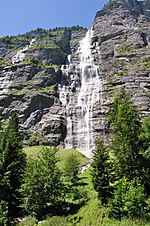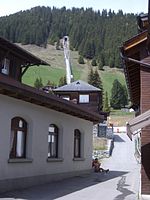Gimmelwald

Gimmelwald is a small traffic free village in the Bernese Oberland in the Canton of Bern, Switzerland, and is located between Stechelberg and Mürren, at an elevation of 1363 meters (4472 feet). The village is at the foot of the UNESCO World Heritage site the Jungfrau-Aletsch Protected Area. Gimmelwald is an allemanic linear village and a walser settlement first mentioned in a bill of sale in 1346. Because of its very typical and exceptional townscape, Gimmelwald is part of the inventory of Swiss heritage.Gimmelwald is one of the few traffic-free villages in Switzerland where access by car is not possible due to a missing road connection. The Schilthorn cable car stops in Gimmelwald, where it is possible to board another cable car which runs between Gimmelwald and Mürren. Farming and tourism are the main source of income today. Farmers raise hay on tiny plots of land to feed small herds of cows. In winter, farmers often work as well for the Schilthorn cable car by performing jobs like running ski lifts or ski-slope grooming. In the year 2003 the population of Gimmelwald was 130. The local school closed in 2010 due to the small number of students and students now attend the school in Lauterbrunnen. The school building was bought in 2019 by a cooperative to convert the school building into flats and to prevent it from being used as a holiday flat.
Excerpt from the Wikipedia article Gimmelwald (License: CC BY-SA 3.0, Authors, Images).Gimmelwald
Egga / Untere Ammerte,
Geographical coordinates (GPS) Address Nearby Places Show on map
Geographical coordinates (GPS)
| Latitude | Longitude |
|---|---|
| N 46.533333333333 ° | E 7.8833333333333 ° |
Address
Egga / Untere Ammerte
3826
Bern, Switzerland
Open on Google Maps










